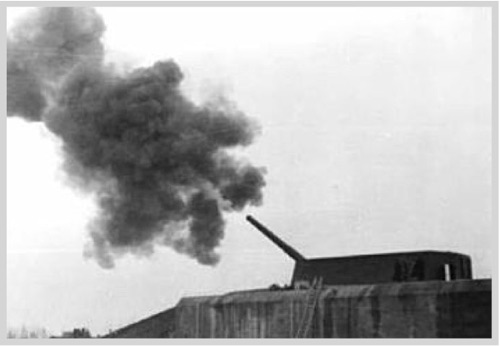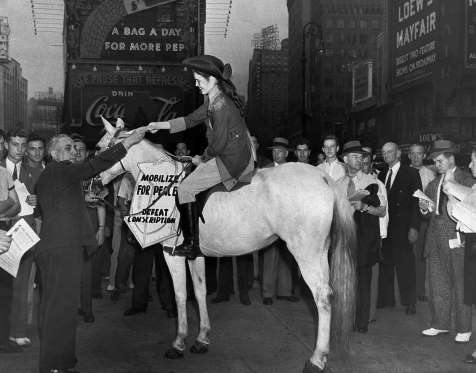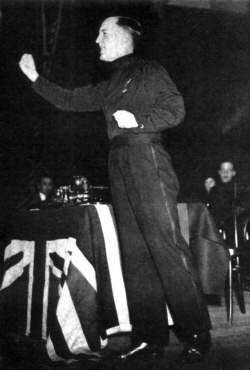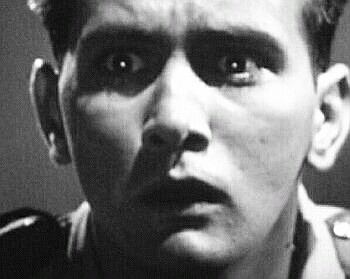Tuesday 13 August 1940
 |
| Messerschmitt Bf 109E-1 of Oberleutnant Paul Temme, Gruppe Adjutant of I/ JG 2 "Richthofen" which crashed near Shoreham airfield in Sussex on 13 August 1940. |
Battle of Britain: Today is the projected start of the final Luftwaffe offensive designed to destroy England. There is morning fog on 13 August 1940, so Reichsmarschall Hermann Goering decides at the last minute to postpone Operation Adlerangriff, which is scheduled to commence today on "Adler Tag" (Eagle Day). However, Goering waits too long and, while he stops some formations, other formations already are in the air on their way to their targets. Rather than an overpowering start, there is a confusing series of disjointed attacks on random targets.
The Luftwaffe is in the air at first light. With radar spotting gathering formations at 05:30, RAF Fighter Command gets Nos. 64 and 111 Squadrons airborne over RAF Hawkinge and Manston to protect the airfields which have become the Luftwaffe's new favorite targets.
Instead of those airfields, though, KG 2 sends over 50 Dornier Do 17s against Eastchurch airfield and the port of Sheerness. Goering's interference, though, prevents most of the escort fighters from meeting them. This is the infamous "bombing raid without escorts." Paradoxically, at first, this works to the Luftwaffe's advantage, as the RAF radar spotters figure the bombing raid is on a much smaller scale than it actually is and fails to send a massive force of interceptors. With little interference, the bombers wreck Eastchurch, destroy a handful of Blenheim bombers on the ground and head back to base. RAF Nos. 74 and 151 make a belated interception and shoot down five of the Dorniers on the way home, but "the damage is done." There are 16 deaths and 48 other casualties at Eastchurch, but the station is back in operation by the end of the day.
Goering finally sends the code for the operation to begin - "Adlerangriff" - in the afternoon at 14:00. This time, the attack is designed to open a seam in the defenses via an elaborate head-fake. A diversionary "free ride" mission by Bf 110s with no target over the south coast draws off the RAF interceptors. The twin-engine fighters lose five planes, but also mete out damage to the Spitfires. Unfortunately, the bombers arrive late - three hours late - and the RAF fighters are back in the air ready to meet them. StG 77 sends 52 Stuka Ju 87 dive bombers against Southampton, the Isle of Wight and nearby points. Despite a fighter escort from JG 53, the massive RAF fighter presence downs 5 bombers, which in any event have little success with their bombing mission due to the weather.
There are other bombing raids that do a little better. An attack on RAF Andover is successful, but it is a secondary airfield and not of much consequence to the overall battle. RAF Middle Wallop takes some damage, but it is not put out of action for long.
An afternoon attack by Stukas proceeding over the Thames estuary is protected by JG 26, probably the premier Luftwaffe formation at this stage of the battle. The Stukas get through, and RAF Detling is their objective. They completely wreck the airfield, which is used by Coastal Command for patrols and reconnaissance. The Stukas kill 67 people and destroy 22 aircraft on the ground for probably the biggest Luftwaffe success of the day. A secondary target, RAF Rochford, is hidden by cloud cover and the Stukas allocated to that target return to their French bases with their bombs.
Towards midnight, Heinkel He 111s attack one of their favorite targets, the Bristol Aeroplane Company at Filton, and also the Spitfire factory at Castle Bromwich, Birmingham. As part of the war of nerves, the Luftwaffe drops special packages by parachute over England and Scotland. The contents of the parachute decoys, which include radios, maps and similar items of use by ground troops, are designed to suggest that the invasion already is in progress - which it, of course, is not.
Top RAF ace James Harry Lacey is shot down during the day by a Heinkel He 111, but survives and immediately returns to his No. 501 Squadron unit at RAF Croydon.
The fault for the fiasco lies in several places: the weather, the meteorologists who predicted good weather, Goering for his interference, the over-complex planning by the Luftwaffe planners, poor target selection (why not just throw everything at the radar stations?), and the quite fundamental fact that the Luftwaffe planes, particularly the medium bombers and dive-bombers, are not suited for their new strategic mission.
At heart, the Luftwaffe failure on Adler Tag is an intelligence failure: the Luftwaffe high command does not realize that the airfields are not the weak link of the RAF defenses, but rather the radar stations are. If the fragile radar masts can be knocked down and their control centers demolished, they will require time and effort to replace them. Simply putting craters into airfields that bulldozers can cover over in a couple of hours is not a strategic solution. The rabid and unproductive attacks against the same targets over and over and over - such as the aircraft factory at Filton near Brighton - show a clear lack of imagination and insight by the planners.
Does Adler Tag by itself decide the campaign? Absolutely not. The Luftwaffe remains ready to ramp up the attacks and the day's losses are manageable. However... things cannot continue like this for the Luftwaffe. The ratio of their losses of both planes and experienced pilots relative to those of the RAF is becoming alarming.
The day is a rude awakening for the Luftwaffe top brass who have been hearing fantasy tales from their pilots who cannot see the forest for the trees and depict a British Empire on the verge of defeat. It is a classic case of the pilots who make it back shouting loudly that everything is going wonderfully, while dead men tell no tales. Anecdotal tales of German aircrew taken prisoner indicate that morale in the Luftwaffe remains sky-high, and the confident captured Germans fully expect to be returning home soon after the invasion (the Luftwaffe, as the youngest of the three services, has the highest concentration of died-in-the-wool Hitler supporters).
There are bright spots for the Germans here and there. One silver lining for the Luftwaffe is that the RAF loses six pilots permanently - but the Germans can't know that, and they also lose valuable pilots and aircrew. A sinister Wehrmacht factor enters the battle today: artillery fire from France. The English Channel at its narrowest is roughly 20 miles (30 km) wide, and there is plenty of German artillery that can reach that far (any battleship main gun could do it, and the Germans actually have bigger guns in their on-land arsenal). Today, the first shells drop on Dover. They are from the Siegfried Battery at Audinghen, south of Cap Gris Nez, the Grosser Kurfürst battery at Cap Gris Nez, as well as various railway guns.
European Air Operations: There is another mitigating factor for the Germans which gets short shrift in the historical accounts of the day. RAF No. 82 Squadron of Bomber Command mounts a disastrous raid on the Luftwaffe airfield at Aalborg West in northern Germany, sending over a dozen bombers. They fly right into a swarm of defending fighters that the RAF has no idea are based there. The Luftwaffe fighters get in the air quickly and shoot down all eleven attacking Blenheim bombers (one turns back). These losses, one of the worst RAF missions of the entire war, are never included in the day's losses during the Battle of Britain, but definitely even up the score a bit.
There also are other RAF operations all along the coast. Several airfields in northwest Europe are hit, and RAF Bomber Command mounts raids of 35 bombers against Italian aircraft factories in Turin and Milan. There also are attacks on German plants at Dessau, Bernburg and elsewhere that cause extensive damage.
Battle of the Atlantic: U-60 (Oberleutnant zur See Adalbert Schnee) torpedoes and sinks 1,787-ton Swedish wood freighter Nils Gorthon about 20 miles north of Ireland. There are 16 survivors and 5 crew perish.
Convoy OA 198 departs from Methil, Convoy 19 departs from Liverpool.
Battle of the Mediterranean: Malta Governor-General Dobbie proposes to Whitehall that stocks of all strategic and non-perishable items be maintained at an 8-months reserve (six months plus two months for the time it takes convoys to make it around Africa). He emphasizes that all items must be maintained at such levels:
Malta remains a functioning RAF base which mounts missions of its own, not just defensive ones. Today, it sends nine Swordfish bombers against shipping in Augusta Harbor, Sicily. Three planes are lost.
In a sign of increasing frustration with the Italians, all Italian street names in the major cities are replaced with English names. This type of switch is a common theme on both sides throughout the war.
British Somaliland: At the Battle of Tug Argan, the Italian attacks on the hills defending the approaches to Berbera continue, with little progress. Having occupied the hills to the south of the coast road, the Italians begin to maneuver around the British blocking position to the south in an attempt to cut the British communications. The British, vastly outnumbered, can do little to prevent this.
The Royal Navy provides support for the British ground forces defending Berbera. Cruiser HMS Carlisle provides air defense, shooting down an Italian bomber, while destroyer HMS Kimberley and sloop HMS Auckland fire on El Sheikha.
US Military: The heavy cruisers USS Wichita and Quincy continue their "Show the flag" mission in South America and leave Pernambuco, Brazil for Montevideo, Uruguay.
US Government: Having returned from his inspection of New England naval facilities aboard the USS Potomac, President Roosevelt confers with his top aides about sending destroyers to the United Kingdom. They hit upon a plan of transferring the destroyers in exchange for long-term leases on British overseas bases and various other promises. Ambassador Joseph Kennedy forwards this welcome news on to Prime Minister Winston Churchill contained in the President's telegram. Churchill, of course, has been asking for this assistance for weeks.
Commanding officer Admiral Thomas C. Hart departs from Qingdao, Shandong, China for Shanghai aboard submarine USS Porpoise.
German Government: Admiral Erich Raeder meets with Hitler and his top cronies about Operation Sea Lion. The heady days of July are gone when he proposed a landing on a broad front all along the southern coast of England. Now, he proposes a much smaller invasion front due to the true state of the Kriegsmarine.
Australia: A plane crash near Canberra in "ideal flying conditions" takes the lives of ten people, including three Cabinet Ministers, the Chief of the General Staff, and several other government officials. The losses include:
Albania: The uprising against the Italian occupation government continues, with unverified reports of hundreds of Italian deaths.
Vichy France: Trials for war guilt open in secret session at Riom, France.
The government bans secret societies such as the Freemasons.
The government also attempts to reassure the public that it will not pass any (more) laws directed against Jews.
Future History: The graves of the crew of one of the Dornier Do 17 bombers shot down in the first raid of the morning, the one without fighter escorts, were dug in a Whitstable, Kent churchyard. The two men were buried in a standard plot, but then the crew of another bomber downed a few days later was buried directly above them in the same plot. When German war graves were transferred to a military cemetery at Staffordshire in 1962, the graves of the crew of the first bomber, buried deeper down than the later crew, were not noticed. Finally, in 2012, historians uncovered the error, and the graves were transferred. The two crewmen were Oberleutnant Horst von der Groeben and Oberleutnant Gerhard Muller, who had bailed out but whose parachutes failed to open. The plane wound up in pieces on the mudflats.
August 1940
August 1, 1940: Two RN Subs Lost
August 2, 1940: Operation Hurry
August 3, 1940: Italians Attack British Somaliland
August 4, 1940: Dueling Legends in the US
August 5, 1940: First Plan for Barbarossa
August 6, 1940: Wipe Out The RAF
August 7, 1940: Burning Oil Plants
August 8, 1940: True Start of Battle of Britain
August 9, 1940: Aufbau Ost
August 10, 1940: Romania Clamps Down On Jews
August 11, 1940: Huge Aerial Losses
August 12, 1940: Attacks on Radar
August 13, 1940: Adler Tag
August 14, 1940: Sir Henry's Mission
August 15, 1940: Luftwaffe's Black Thursday
August 16, 1940: Wolfpack Time
August 17, 1940: Blockade of Britain
August 18, 1940: The Hardest Day
August 19, 1940: Enter The Zero
August 20, 1940: So Much Owed By So Many
August 21, 1940: Anglo Saxon Incident
August 22, 1940: Hellfire Corner
August 23, 1940: Seaplanes Attack
August 24, 1940: Slippery Slope
August 25, 1940: RAF Bombs Berlin
August 26, 1940: Troops Moved for Barbarossa
August 27, 1940: Air Base in Iceland
August 28, 1940: Call Me Meyer
August 29, 1940: Schepke's Big Day
August 30, 1940: RAF's Bad Day
August 31, 1940: Texel Disaster
2020
The Luftwaffe is in the air at first light. With radar spotting gathering formations at 05:30, RAF Fighter Command gets Nos. 64 and 111 Squadrons airborne over RAF Hawkinge and Manston to protect the airfields which have become the Luftwaffe's new favorite targets.
Instead of those airfields, though, KG 2 sends over 50 Dornier Do 17s against Eastchurch airfield and the port of Sheerness. Goering's interference, though, prevents most of the escort fighters from meeting them. This is the infamous "bombing raid without escorts." Paradoxically, at first, this works to the Luftwaffe's advantage, as the RAF radar spotters figure the bombing raid is on a much smaller scale than it actually is and fails to send a massive force of interceptors. With little interference, the bombers wreck Eastchurch, destroy a handful of Blenheim bombers on the ground and head back to base. RAF Nos. 74 and 151 make a belated interception and shoot down five of the Dorniers on the way home, but "the damage is done." There are 16 deaths and 48 other casualties at Eastchurch, but the station is back in operation by the end of the day.
Goering finally sends the code for the operation to begin - "Adlerangriff" - in the afternoon at 14:00. This time, the attack is designed to open a seam in the defenses via an elaborate head-fake. A diversionary "free ride" mission by Bf 110s with no target over the south coast draws off the RAF interceptors. The twin-engine fighters lose five planes, but also mete out damage to the Spitfires. Unfortunately, the bombers arrive late - three hours late - and the RAF fighters are back in the air ready to meet them. StG 77 sends 52 Stuka Ju 87 dive bombers against Southampton, the Isle of Wight and nearby points. Despite a fighter escort from JG 53, the massive RAF fighter presence downs 5 bombers, which in any event have little success with their bombing mission due to the weather.
There are other bombing raids that do a little better. An attack on RAF Andover is successful, but it is a secondary airfield and not of much consequence to the overall battle. RAF Middle Wallop takes some damage, but it is not put out of action for long.
An afternoon attack by Stukas proceeding over the Thames estuary is protected by JG 26, probably the premier Luftwaffe formation at this stage of the battle. The Stukas get through, and RAF Detling is their objective. They completely wreck the airfield, which is used by Coastal Command for patrols and reconnaissance. The Stukas kill 67 people and destroy 22 aircraft on the ground for probably the biggest Luftwaffe success of the day. A secondary target, RAF Rochford, is hidden by cloud cover and the Stukas allocated to that target return to their French bases with their bombs.
Towards midnight, Heinkel He 111s attack one of their favorite targets, the Bristol Aeroplane Company at Filton, and also the Spitfire factory at Castle Bromwich, Birmingham. As part of the war of nerves, the Luftwaffe drops special packages by parachute over England and Scotland. The contents of the parachute decoys, which include radios, maps and similar items of use by ground troops, are designed to suggest that the invasion already is in progress - which it, of course, is not.
Top RAF ace James Harry Lacey is shot down during the day by a Heinkel He 111, but survives and immediately returns to his No. 501 Squadron unit at RAF Croydon.
The fault for the fiasco lies in several places: the weather, the meteorologists who predicted good weather, Goering for his interference, the over-complex planning by the Luftwaffe planners, poor target selection (why not just throw everything at the radar stations?), and the quite fundamental fact that the Luftwaffe planes, particularly the medium bombers and dive-bombers, are not suited for their new strategic mission.
At heart, the Luftwaffe failure on Adler Tag is an intelligence failure: the Luftwaffe high command does not realize that the airfields are not the weak link of the RAF defenses, but rather the radar stations are. If the fragile radar masts can be knocked down and their control centers demolished, they will require time and effort to replace them. Simply putting craters into airfields that bulldozers can cover over in a couple of hours is not a strategic solution. The rabid and unproductive attacks against the same targets over and over and over - such as the aircraft factory at Filton near Brighton - show a clear lack of imagination and insight by the planners.
Does Adler Tag by itself decide the campaign? Absolutely not. The Luftwaffe remains ready to ramp up the attacks and the day's losses are manageable. However... things cannot continue like this for the Luftwaffe. The ratio of their losses of both planes and experienced pilots relative to those of the RAF is becoming alarming.
The day is a rude awakening for the Luftwaffe top brass who have been hearing fantasy tales from their pilots who cannot see the forest for the trees and depict a British Empire on the verge of defeat. It is a classic case of the pilots who make it back shouting loudly that everything is going wonderfully, while dead men tell no tales. Anecdotal tales of German aircrew taken prisoner indicate that morale in the Luftwaffe remains sky-high, and the confident captured Germans fully expect to be returning home soon after the invasion (the Luftwaffe, as the youngest of the three services, has the highest concentration of died-in-the-wool Hitler supporters).
There are bright spots for the Germans here and there. One silver lining for the Luftwaffe is that the RAF loses six pilots permanently - but the Germans can't know that, and they also lose valuable pilots and aircrew. A sinister Wehrmacht factor enters the battle today: artillery fire from France. The English Channel at its narrowest is roughly 20 miles (30 km) wide, and there is plenty of German artillery that can reach that far (any battleship main gun could do it, and the Germans actually have bigger guns in their on-land arsenal). Today, the first shells drop on Dover. They are from the Siegfried Battery at Audinghen, south of Cap Gris Nez, the Grosser Kurfürst battery at Cap Gris Nez, as well as various railway guns.
 |
| The 13 August 1940 headlines are full of tales of glory. |
There also are other RAF operations all along the coast. Several airfields in northwest Europe are hit, and RAF Bomber Command mounts raids of 35 bombers against Italian aircraft factories in Turin and Milan. There also are attacks on German plants at Dessau, Bernburg and elsewhere that cause extensive damage.
Battle of the Atlantic: U-60 (Oberleutnant zur See Adalbert Schnee) torpedoes and sinks 1,787-ton Swedish wood freighter Nils Gorthon about 20 miles north of Ireland. There are 16 survivors and 5 crew perish.
Convoy OA 198 departs from Methil, Convoy 19 departs from Liverpool.
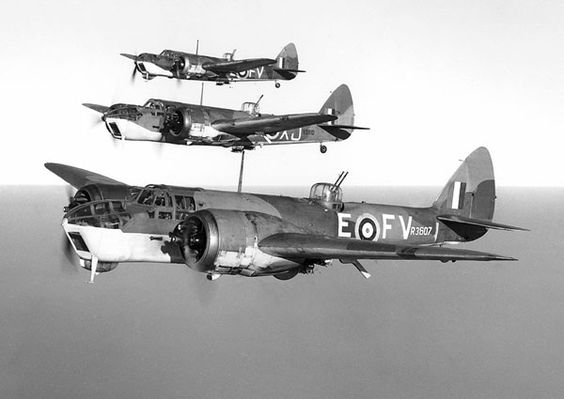 |
| Blenheim bombers of the type shot down over Aalborg on 13 August 1940. |
If the ability of this fortress to resist attack is not uniformly strong, weakness at one point will affect the whole.Whitehall is sympathetic, and also asks for lists of items which might improve soldier morale on the island, including such things as cigarettes and books.
Malta remains a functioning RAF base which mounts missions of its own, not just defensive ones. Today, it sends nine Swordfish bombers against shipping in Augusta Harbor, Sicily. Three planes are lost.
In a sign of increasing frustration with the Italians, all Italian street names in the major cities are replaced with English names. This type of switch is a common theme on both sides throughout the war.
British Somaliland: At the Battle of Tug Argan, the Italian attacks on the hills defending the approaches to Berbera continue, with little progress. Having occupied the hills to the south of the coast road, the Italians begin to maneuver around the British blocking position to the south in an attempt to cut the British communications. The British, vastly outnumbered, can do little to prevent this.
The Royal Navy provides support for the British ground forces defending Berbera. Cruiser HMS Carlisle provides air defense, shooting down an Italian bomber, while destroyer HMS Kimberley and sloop HMS Auckland fire on El Sheikha.
US Military: The heavy cruisers USS Wichita and Quincy continue their "Show the flag" mission in South America and leave Pernambuco, Brazil for Montevideo, Uruguay.
 |
| British soldiers inspect a gun mount from a Luftwaffe bomber downed on Adler Tag. |
Commanding officer Admiral Thomas C. Hart departs from Qingdao, Shandong, China for Shanghai aboard submarine USS Porpoise.
German Government: Admiral Erich Raeder meets with Hitler and his top cronies about Operation Sea Lion. The heady days of July are gone when he proposed a landing on a broad front all along the southern coast of England. Now, he proposes a much smaller invasion front due to the true state of the Kriegsmarine.
 |
| Wreckage of the fatal Canberra, Australia crash, 13 August 1940. |
- Brigadier Geoffrey Austin Street, Minister for the Army and Repatriation;
- James Valentine Fairbairn, Minister for Air and Civil Aviation;
- Sir Henry Somer Gullett, Vice-President of the Executive Council and Minister in charge of Scientific and Industrial Research;
- General Sir Cyril Brudenell Bingham White, Chief of the General Staff;
- Lieutenant Colonel Francis Thornthwaite, Staff Officer to General White.
Albania: The uprising against the Italian occupation government continues, with unverified reports of hundreds of Italian deaths.
Vichy France: Trials for war guilt open in secret session at Riom, France.
The government bans secret societies such as the Freemasons.
The government also attempts to reassure the public that it will not pass any (more) laws directed against Jews.
Future History: The graves of the crew of one of the Dornier Do 17 bombers shot down in the first raid of the morning, the one without fighter escorts, were dug in a Whitstable, Kent churchyard. The two men were buried in a standard plot, but then the crew of another bomber downed a few days later was buried directly above them in the same plot. When German war graves were transferred to a military cemetery at Staffordshire in 1962, the graves of the crew of the first bomber, buried deeper down than the later crew, were not noticed. Finally, in 2012, historians uncovered the error, and the graves were transferred. The two crewmen were Oberleutnant Horst von der Groeben and Oberleutnant Gerhard Muller, who had bailed out but whose parachutes failed to open. The plane wound up in pieces on the mudflats.
 |
| The crashed Dornier of Oberleutnant Horst von der Groeben and Oberleutnant Gerhard Muller on 13 August 1940. |
August 1, 1940: Two RN Subs Lost
August 2, 1940: Operation Hurry
August 3, 1940: Italians Attack British Somaliland
August 4, 1940: Dueling Legends in the US
August 5, 1940: First Plan for Barbarossa
August 6, 1940: Wipe Out The RAF
August 7, 1940: Burning Oil Plants
August 8, 1940: True Start of Battle of Britain
August 9, 1940: Aufbau Ost
August 10, 1940: Romania Clamps Down On Jews
August 11, 1940: Huge Aerial Losses
August 12, 1940: Attacks on Radar
August 13, 1940: Adler Tag
August 14, 1940: Sir Henry's Mission
August 15, 1940: Luftwaffe's Black Thursday
August 16, 1940: Wolfpack Time
August 17, 1940: Blockade of Britain
August 18, 1940: The Hardest Day
August 19, 1940: Enter The Zero
August 20, 1940: So Much Owed By So Many
August 21, 1940: Anglo Saxon Incident
August 22, 1940: Hellfire Corner
August 23, 1940: Seaplanes Attack
August 24, 1940: Slippery Slope
August 25, 1940: RAF Bombs Berlin
August 26, 1940: Troops Moved for Barbarossa
August 27, 1940: Air Base in Iceland
August 28, 1940: Call Me Meyer
August 29, 1940: Schepke's Big Day
August 30, 1940: RAF's Bad Day
August 31, 1940: Texel Disaster
2020
